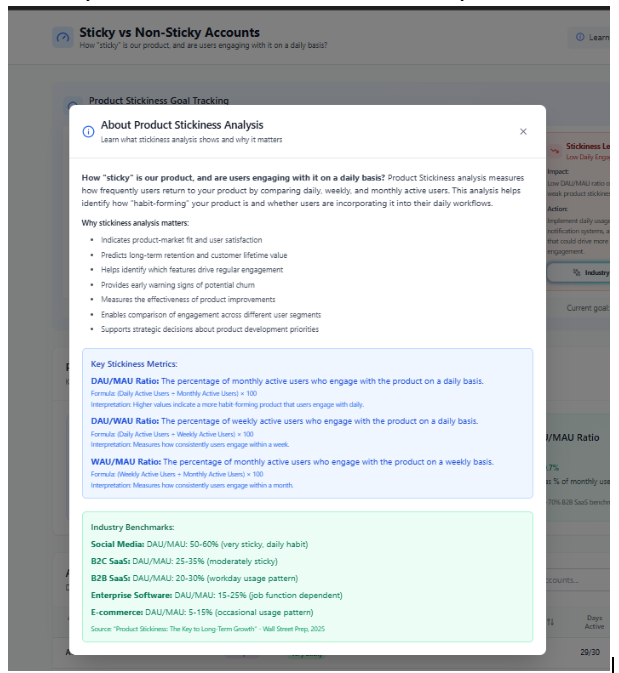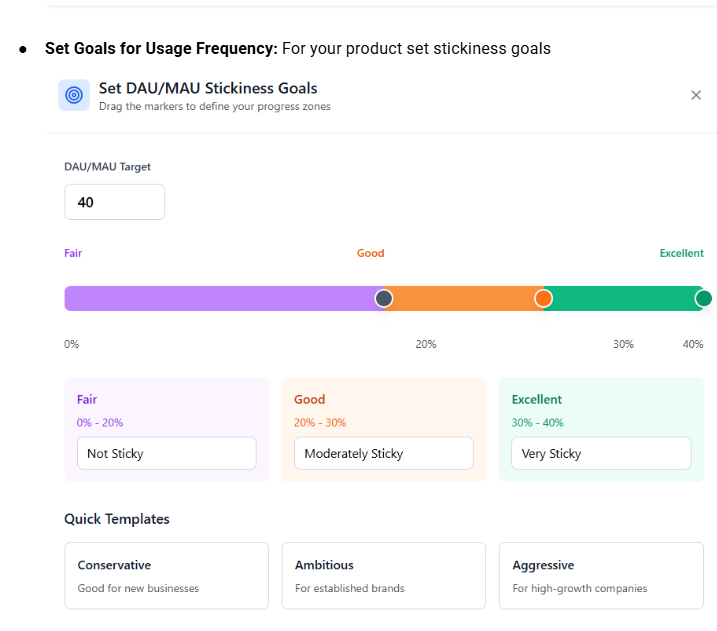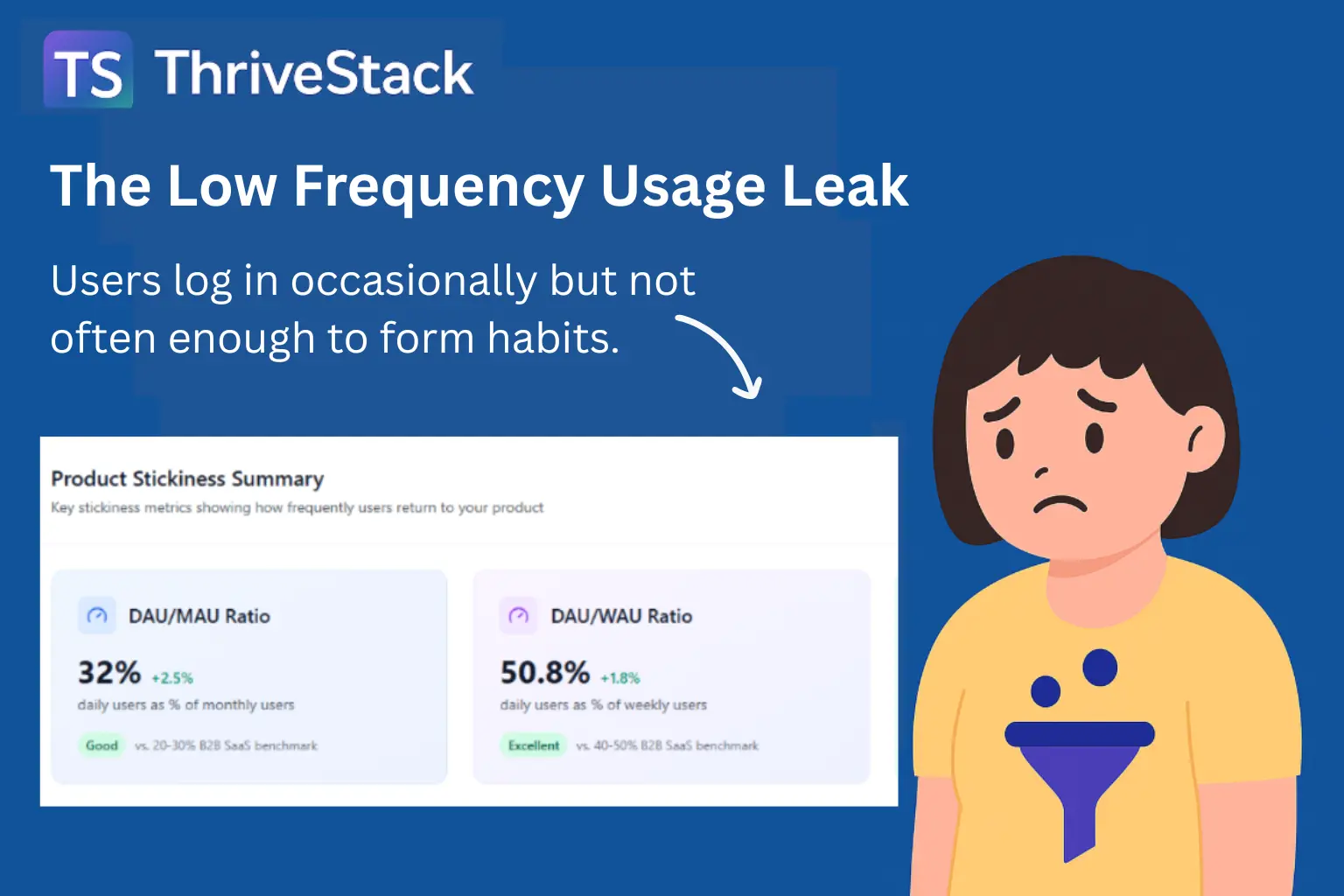"If they don’t use it, you’ll lose them —forever."
Leak Description: The Low Frequency Usage Leak
The Low Frequency Usage Leak is when your users aren’t returning to your product as often as they need to truly succeed. Instead of building a sticky, recurring relationship with your SaaS, customers check in sporadically—resulting in lower value, more churn, and slow growth. This isn’t just about login rates; it’s about a failure to make your product a true habit.
Example:
Imagine a project management SaaS designed for daily standups, but most teams only log in once every two weeks. Instead of being an everyday part of team rituals, the product becomes an afterthought—and eventually gets replaced by something stickier, like Slack or Notion.
Why You Should Care About the Low Frequency Usage Leak
Low frequency usage is a death sentence for SaaS. Research from Mixpanel shows that SaaS companies with weekly active user rates below 25% experience 2.3x higher churn and dramatically lower net retention.
Growth Expert Quote:
“Engagement isn’t an afterthought—it’s the leading indicator of whether your SaaS will thrive or die.”
— Brian Balfour, CEO @ Reforge
If you want to drive expansion revenue, improve NRR, and make your product truly defensible, you have to keep customers coming back.
Why the Low Frequency Usage Leak Happens
Most teams over-index on acquisition, assuming product value is self-evident. In reality, frequency falters because:
- The core habit loop is unclear or missing
- Onboarding fails to drive recurring action
- Users never cross the threshold to “aha” moments
- Value is hidden behind complexity or unnecessary friction
- The product doesn’t feel urgent or necessary
The Psychology Behind It:
As behavioral scientist Laurie Santos notes, "Habits are built through cues, routine, and reward—not just intention." If your product doesn’t become a natural part of the customer’s workflow, it won’t stick.
How to Detect the Low Frequency Usage Leak
You can’t fix what you don’t track. Diagnose the leak using industry-standard “stickiness” metrics:
Sources:
Diagnostic Steps:
- Pull DAU/MAU and WAU/MAU ratios from analytics tools
- Segment by cohort, plan, persona, and use-case
- Map activity trends against churn and expansion events
- Interview a sample of inactive or low-frequency users for context
How ThriveStack Can Help with the Low Frequency Usage Leak
Please review the content. This is auto-generated and may not match the product features
Note: Prateek, please add product walkthroughs for this section
Features
Understand your Product’s Stickiness benchmarks across the industry

Engagement Analytics: Real-time product stickiness dashboards (covers DAU/MAU and WAU/MAU metrics) and cohort reports.

Set Goals for Usage Frequency: For your product set stickiness goals

Detection Steps
- Install ThriveStack’s SDK to enable Product Stickiness tracking.
- Review engagement across accounts and Users.
- Run “Return user” analysis.
- Use the friction finder to spot and fix onboarding dead ends.
Fix Actions
- Launch automated nudges for infrequent users (email, in-app)
- Personalize prompts to highlight value-driving actions
- Simplify core workflows and eliminate unnecessary steps
- Celebrate micro-successes to reinforce recurring engagement
Prevention Strategies
- Design product triggers that bring users back on a schedule (e.g., reminders, value updates)
- Layer in milestone rewards and check-ins
- A/B test different notification strategies to optimize user return
Customer Psychology:
Why This Fix Works
Users want tools that fit their routine, not more noise. ThriveStack’s approach taps the science of habit-formation:
“Behavioral reinforcement—small, regular wins—turns occasional use into automatic use.”
— Katy Milkman, Behavioral Scientist
By triggering relevant, timely nudges, you create the cues and rewards needed to make your product a habit, not just a tool.
Business Impact of Fixing the Low Frequency Usage Leak
- Churn can fall by 30–40% by improving weekly usage rates from 20% to 40% (SaaS Capital)
- Habitual users are 3x more likely to expand and 2x more likely to refer
- NPS and advocacy scores improve as perceived value rises
Customer Quote:
“After closing our usage leak with ThriveStack, we saw a 35% boost in weekly active users and our expansion revenue jumped within a quarter.”
Growth Expert Quotes
- “The first sign of a failing SaaS is low engagement. Design your product for habits, not just features.” — Elena Verna, Growth Advisor
- “If you want to fix retention, start with usage frequency. There’s no shortcut.” — Hila Qu, Growth Consultant
Ready to Fix the Low Frequency Usage Leak?
ThriveStack’s intelligent analytics and habit-building tools help SaaS teams spot, fix, and prevent low usage leaks before they erode growth. Sign up for a demo or free trial and reclaim your lost engagement now.
Conclusion: Turn Occasional Users into Loyal Power Users
The Low Frequency Usage Leak is one of the most dangerous growth killers in SaaS—but it’s also one of the most fixable. By making your product part of a user’s regular workflow, you reduce churn, increase expansion, and strengthen long-term retention.
ThriveStack helps you detect, fix, and prevent usage leaks with real-time engagement analytics, habit-forming nudges, and product workflow insights.
Take Action Now
Get your free ThriveStack demo and start transforming occasional users into daily advocates. Don’t let another user slip away.
Frequently Asked Questions
1. What is the Low Frequency Usage Leak?
It’s when users don’t engage with your product often enough to build lasting habits, leading to churn.
2. How do I know if my SaaS has this problem?
Track your DAU/MAU and WAU/MAU ratios. If daily or weekly usage is below 30%, you likely have a usage leak.
3. Why does low frequency usage hurt my business?
Low usage leads to higher churn, lower customer lifetime value (CLV), and reduced expansion revenue. It’s a growth blocker.
4. Can ThriveStack help fix this issue?
Yes! ThriveStack provides stickiness analytics, personalized nudges, and workflow optimizations to drive consistent product engagement.
5. How do I get started with ThriveStack?
Visit www.thrivestack.ai to request a free trial or book a personalized demo.

